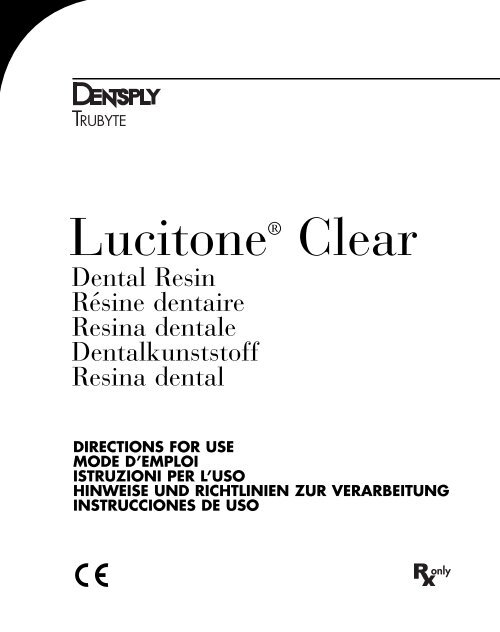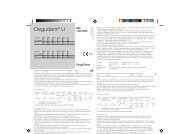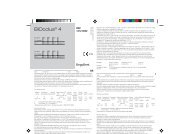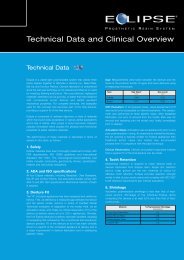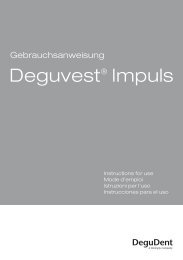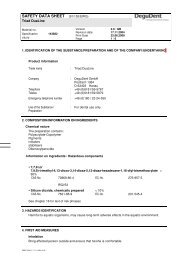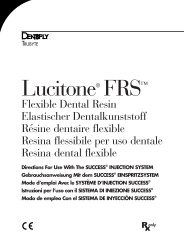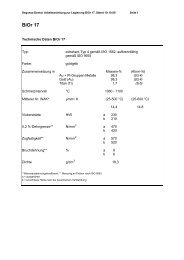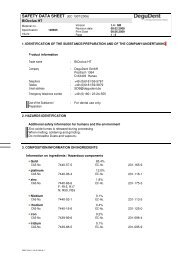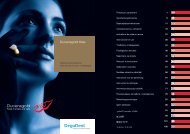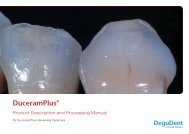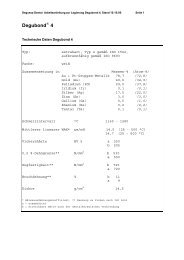Lucitone® Clear - DENTSPLY Prosthetics
Lucitone® Clear - DENTSPLY Prosthetics
Lucitone® Clear - DENTSPLY Prosthetics
- No tags were found...
You also want an ePaper? Increase the reach of your titles
YUMPU automatically turns print PDFs into web optimized ePapers that Google loves.
Lucitone ®Dental ResinRésine dentaireResina dentaleDentalkunststoffResina dental<strong>Clear</strong>DIRECTIONS FOR USEMODE D’EMPLOIISTRUZIONI PER L’USOHINWEISE UND RICHTLINIEN ZUR VERARBEITUNGINSTRUCCIONES DE USO
Indications for Use:LUCITONE CLEAR Dental Resin is a powderand liquid system based on polymethylmethacrylate, intended for use in the fabricationof clear dental appliances such asocclusal splints.Contraindications:1. LUCITONE CLEAR Dental Resin is contraindicatedfor patients and users with ahistory of allergic reaction to methylmethacrylate monomer.Warnings:1. LUCITONE CLEAR Dental Resin containspolymerizable monomers which maycause skin sensitization (allergic contactdermatitis) or other allergic reactions insusceptible persons. Wash thoroughlywith soap and water after contact. If dermatitisor other symptoms persist, seekmedical advice.2. Avoid inhalation or ingestion. High vaporconcentration can induce headache,nausea, and irritation of eyes and respiratorysystem. Liquid contact with eyes maycause possible corneal damage. Excessivelong-term exposure may be associatedwith other more serious health effects.Monitor air quality per OSHA standards.Inhalation: Move subject to fresh air.Give oxygen or artificial respiration asrequired.Ingestion: Contact your regional PoisonControl Center immediately.Eye Contact: Flush eyes promptly withcopious amounts of water for 15 minutes;consult a physician. Wash skin with soapand water.Precautions:1. Users with special skin problems, cuts, orabrasions should wear protective gloves.2. When grinding prosthodontic resins,proper ventilation, masks, and vacuumsystems should be used.3. Store at 60°-80°F (16-27°C), away frommoisture and direct sunlight. The liquidcontains unsaturated monomers whichmay polymerize prematurely if stored atexcessively high temperature and/or insunlight. The powder contains an organicpolymerization initiator which maydegrade if stored at excessively high temperature.4. Lucitone Liquid and LUCITONE CLEARDental Resin uncured resin are hazardousmaterials. Dispose of in accordance withFederal, State, and Local regulations.5. Lucitone Liquid contains methyl methacrylatemonomer, a flammable liquid with aflash point of 50°F (10°C). Keep awayfrom heat, sparks, and open flame.6. Use liquid in a well-ventilated area.Replace cap when not in use.7. Do not pack denture resin after work timehas elapsed or material has becomerubbery.8. DO NOT USE the long cure cycle [9hours at 163°F (73°C)] for processingLUCITONE CLEAR Dental Resin. The longcure cycle will not produce optimumclarity of LUCITONE CLEAR Dental Resin.Adverse Reactions:1. Corneal damage, headache, nausea, andvomiting may occur with exposure tomethyl methacrylate monomer. (SeeWarnings and Precautions statements.)2. Allergic contact dermatitis and other allergicreactions may occur in susceptibleindividuals. Residual monomer in fullycured materials can be minimized bysoaking the cured prosthesis in warmwater for several days.3. Particulates will be generated when grindingacrylic resins. Eye, skin, and respiratoryirritation may occur if appropriateengineering controls are not used.1
STEP-BY-STEP INSTRUCTIONS:PROPERTIES AND RECOMMENDED PROCEDURESThe following table describes typical properties of LUCITONE CLEAR Dental Resin,plus recommended temperatures and other important processing information. Furtherdetail of this information is found later in the text.ISO Standard 1567Type and Class (according to ADA Spec. 12) ............................Type I Class 1Storage temperature for powder and liquid ......................60°-80°F (16°-27°C)Powder/Liquid ratio ........................................................21 g (32 cc)/10 mlMixing time (time to wet all particles) .......................................15-30 secondsTime to reach packing plasticity @ 73° ±2°F (23° ±1°C) ...............9±2 minutesWorking time ............................................................................8±4 minutesMaterial used to prepare mould.........................................................gypsumTemperature of mould when packing .............................approx. 110°F (43°C)Recommended cure time and temperature1st stage.........................................1 1 ⁄2 hours @ 163°F (73°C)2nd stage......................................... 1 ⁄2 hour @ 212°F (100°C)Method of cooling flask, time and temperature1st stage.......................... 1 ⁄2 hour in air @ 60°-80°F (16°-27°C)2nd stage.................... 1 ⁄4 hour in water @ 60°-80°F (16°-27°C)FLASKINGUse conventional dental compression mouldingor the Success ®Injection System, andgypsum materials for flasking.WAX ELIMINATIONSoften wax in boiling water for approximately6 minutes. Separate flask and removewax by flushing with a solution of boilingwater and detergent.Use clean boiling water for the final flush.DO NOT USE WAX SOLVENTS. Be sure caseis free of wax and grease.TINFOIL SUBSTITUTEApply AL-COTE ® Separator liberally to areasof the warm mould [approx. 120°F (49°C)]that will contact the resin. Remove excess AL-COTE film with a dry brush. (AL-COTESeparator does not form a film on teeth.)Allow AL-COTE Separator to dry thoroughly(approx. 3 minutes following application)before packing the resin.IMPORTANTMeasure powder and liquid accurately. Donot whip air into mix by excessive spatulation.MIXINGTo assure uniformity, shake powder jar (witha rocking motion) to prevent concentration ofsmall particles at the bottom of jar. Add 1unit of powder (21 gm or 32 cc) to 10 mlLUCITONE Liquid. Stir sufficiently (15-30seconds) to assure wetting of all powder particles.Do not over-mix. Cover mixing jar andallow material to reach packing consistency[approx. 9 minutes at room temperature of73° ± 2°F (23° ±1°C)].PACKINGLUCITONE CLEAR Dental Resin should be2
packed in a warm flask [approx.110°F(43°C)]. The correct packing consistency isidentified when the resin dough is free fromstickiness but not rubbery. Remove resindough from jar and condense with fingerpressure into mould or place into SuccessInjection Cartridge.TRIAL PACKING IN COMPRESSIONPACK CASESPlace assembled flask in bench press andapply pressure slowly. If trial pack indicatesinsufficient resin in some areas, remove cellophaneand add resin. Replace cellophaneand repeat trial packing. Make certain thereis a slight excess of resin. CLOSE FLASKSLOWLY. Open flask, remove cellophane,and trim off excess resin. Apply AL-COTE filmafter trial packing has been completed. Besure AL-COTE film is thoroughly dry prior tofinal closure. Then place assembled flask inbench press for final closure. The closed flaskshould remain under pressure for approximately30 minutes before the heat-cure procedureis started.SUCCESS ® INJECTION PROCESSFollow directions for the Success InjectionSystem. Inject for 1 minute.WORK TIMEThe work time of LUCITONE CLEAR DentalResin is approximately 8 minutes. Neverpack or inject after the work time haselapsed or the material has become rubbery.CURINGSubmerge closed flask (locked by compress,spring clamps or Success Flask Brackets) inwater at 163° ±2°F (73° ±1°C) for 1 1 ⁄2hours. Follow by 1 ⁄2 hour in boiling water. Aperiodic check of water bath temperaturewith an accurate thermometer is recommended.IMPORTANT: DO NOT USE THE LONGCURE CYCLE [9 HOURS AT 163˚F (73° C)]FOR PROCESSING LUCITONE CLEARDENTAL RESIN. THE LONG CURE CYCLEWILL NOT PRODUCE OPTIMUM CLARITYOF LUCITONE CLEAR DENTAL RESIN.COOLINGBench cool the flask at room temperature for30 minutes. Then immerse in cool water[60°-80°F (16°-27°C)] for 15 minutes beforedeflasking.FINISHING AND POLISHINGLUCITONE CLEAR Dental Resin should be finishedand polished in the same manner asdenture base resins.SHADE RECOMMENDATIONSREPAIR MATERIAL DENTURE BASE RESINSPINKLUCITONE ® (pink) andHY-PRO LUCITONE ® PlainHY-PRO LUCITONE ® FiberedPINK FIBEREREDCharacterized LUCITONE ®LIGHT FIBEREDLt. Red, Pink, Red, and othersCharacterized LUCITONE ® LightHY-PRO LUCITONE ® FiberedLight, and LUCITONE 199 ®Marca Registrada - Chile, Guatemala, Mexico. The Trademark underwhich this product is sold is registered in various countries.3
Indications :La résine dentaire LUCITONE CLEAR est unsystème mixte de poudre et de liquide à base depolyméthyle méthacrylate, servant à la fabricationd’appareils dentaires transparents tels que desattelles occlusales.Contre-indications :1. La résine dentaire LUCITONE CLEAR est contreindiquéepour les patients et les utilisateurs présentantdes antécédents de réactions allergiques aumonomère de méthacrylate de méthyle.Avertissements :1. La résine dentaire LUCITONE CLEAR contientdes monomères polymérisables qui risquentde provoquer des sensibilisations cutanées(dermatites de contact allergiques) ou d’autresréactions allergiques chez les personnes prédisposées.Lavez abondamment la peau avec del’eau et du savon après tout contact.Consultez un médecin si les dermatites oud’autres symptômes persistent.2. Évitez l’inhalation et l’ingestion. Les concentrationsélevées de vapeur risquent de provoquerdes céphalées, nausées et irritationsoculaires et respiratoires. Le contact duliquide avec les yeux pourrait provoquerd’éventuelles lésions de la cornée. Des expositionsà long terme excessives peuvent êtreassociées à d’autres effets plus graves sur lasanté. Surveillez la qualité de l’air conformémentaux normes OSHA.Inhalation : mettez le sujet à l’air frais.Administrez oxygène et respiration artificiellele cas échéant.Ingestion : contactez immédiatement lecentre antipoison régional.Contact oculaire : rincez très rapidementles yeux avec des quantités abondantes d’eaupendant 15 minutes ; consultez un médecin.Lavez la peau avec de l’eau et du savon.Précautions :1. Les utilisateurs présentant des problèmes cutanésparticuliers, tels que coupures ou écorchures,doivent porter des gants de protection.2. Il est recommandé de meuler la résine pourprothèse dans un local adéquatement ventilé,sous aspiration et en portant un masque.43. Conservez à une température comprise entre16 et 27 °C, à l’écart de l’humidité et de lalumière directe du soleil. Le liquide contientdes monomères non saturés qui risquent dese polymériser prématurément s’ils sont conservésà une température excessivementélevée et / ou sous la lumière directe dusoleil. La poudre contient un initiateur depolymérisation organique qui risque de sedégrader s’il est conservé à une températureexcessivement élevée.4. Le liquide Lucitone et la résine dentaireLUCITONE CLEAR non polymérisée sont desmatériaux dangereux. Jetez-les conformémentaux réglementations fédérales, d'état et locales.5. Le liquide Lucitone contient du monomère deméthacrylate de méthyle, un liquide inflammabledont le point d’éclair se situe à 10 °C.Maintenez à l’écart de la chaleur, des étincelleset des flammes nues.6. Utilisez dans un endroit bien aéré. Remettezle bouchon lorsque le produit n’est pas utilisé.7. Ne compactez pas la résine de prothèse dentaireune fois que le temps de travail s’est écouléou que le produit est devenu caoutchouteux.8. N’UTILISEZ PAS le cycle long de polymérisation(9 heures à 73 °C) pour le traitementde la résine dentaire LUCITONE CLEAR. Lecycle long de polymérisation ne donnera pasla transparence optimale de la résine dentaireLUCITONE CLEAR.Effets indésirables :1. L’exposition au monomère de méthacrylatede méthyle peut entraîner des lésions de lacornée, des céphalées, des nausées et desvomissements. (Reportez-vous aux avertissementset aux précautions.)2. Certaines personnes prédisposées peuventprésenter des dermatites de contact oud'autres réactions allergiques. Le monomèrerésiduel des produits complètement polymériséspeut être minimisé en faisant tremperla prothèse polymérisée plusieurs jours dansde l’eau chaude.3. Le meulage des résines acryliques génère desparticules. Des irritations cutanées, oculaireset respiratoires risquent de se produire si leséquipements de contrôle appropriés ne sontpas utilisés.
GUIDE D’UTILISATION :PROPRIÉTÉS ET PROCÉDURES RECOMMANDÉESLe tableau suivant décrit les propriétés caractéristiques de la résine dentaire LUCITONE CLEAR ainsi queles températures recommandées et les autres informations importantes concernant le traitement. De plusamples informations sont données plus loin dans le texte.Norme ISO 1567Type et classe (conformément à la spécification 12 de l'ADA). ..................Type I, Classe 1Température de conservation pour la poudre et le liquide................................16 – 27 °CRapport poudre / liquide...............................................................21 g (32 cc) / 10 mlTemps de mélange (temps requis pour mouiller toutes les particules)........15 – 30 secondesTemps pour atteindre la plasticité de compactage à 23 °C ±1 °C..................9 ±2 minutesTemps de travail .......................................................................................8 ±4 minutesMatériau utilisé pour préparer le moule .................................................................gypseTempérature du moule pendant le compactage...........................................environ 43 °CTemps et température de polymérisation recommandés1ère phase................................................................1 1 ⁄2 heure à 73 °C2ème phase................................................................ 1 ⁄2 heure à 100 °CMéthode de refroidissement du moufle, temps et température1ère phase ..................................... 1 ⁄2 heure à l’air ambiant à 16 – 27 °C2ème phase.......................................... 1 ⁄4 heure dans l’eau à 16 – 27 °CMISE EN MOUFLEUtilisez la méthode traditionnelle de moulage parcompression ou le système à injection Success ® etdu gypse pour la mise en moufle.ÉLIMINATION DE LA CIRERamollissez la cire dans de l’eau bouillantependant environ 6 minutes. Séparez le moufle etéliminez la cire en rinçant avec une solution d’eaubouillante et de détergent.Utilisez de l’eau bouillante pure pour le dernierrinçage. N’UTILISEZ PAS DES SOLVANTS DE LACIRE. Assurez-vous que le boîtier est exempt decire et de graisse.SUBSTITUT DE LA FEUILLE D’ÉTAINAppliquez le séparateur AL-COTE ® en quantitégénéreuse sur les surfaces du moule chaud(approximativement 49 °C) qui entreront encontact avec la résine. Supprimez l’excédentd’AL-COTE avec une brosse sèche. (Le séparateurAL-COTE ne forme pas de film sur les dents.)Laissez le séparateur AL-COTE complètementsécher (environ 3 minutes après son application)avant de compacter la résine.IMPORTANTMesurez la poudre et le liquide avec précision.N’introduisez pas d’air dans le mélange en lespatulant de façon excessive.MÉLANGEPour assurer l’uniformité, agitez le flacon depoudre (avec un mouvement de va-et-vient) afind’éviter la concentration des petites particules aufond du flacon. Ajoutez une unité de poudre(21 g ou 32 cc) à 10 ml de liquide LUCITONE.Remuez suffisamment (15 – 30 secondes) pourassurer le mouillage de toutes les particules depoudre. Ne mélangez pas trop. Couvrez le flaconde mélange et laissez le matériau parvenir à laconsistance de compactage (environ 9 minutes àtempérature ambiante de 23 °C ± 1 °C).COMPACTAGELa résine dentaire LUCITONE CLEAR doit être compactéedans un moufle chaud (environ 43 °C). Laconsistance de compactage appropriée correspondà une pâte de résine non collante maisnon caoutchouteuse. Retirez la pâte de résinedu flacon et enfoncez-la avec les doigts dans lemoufle ou mettez-la dans la cartouche d’injectionSuccess.5
COMPACTAGE D’ESSAI DANS DES BOÎTIERSDE COMPACTAGE PAR COMPRESSIONPlacez le moufle monté dans une presse de paillasseet appliquez lentement la pression. Si lecompactage d’essai indique un manque de résinedans certains endroits, enlevez la cellophane etrajoutez de la résine. Remettez la cellophane etréessayez le compactage. Assurez-vous qu’il y aun léger excédent de résine. FERMEZ LE MOUFLELENTEMENT. Ouvrez le moufle, retirez la cellophaneet éliminez les excédents de résine.Appliquez une couche d’AL-COTE une fois que lecompactage d’essai est terminé. Assurez-vous quela couche d’AL-COTE est complètement sècheavant la fermeture finale. Placez alors le mouflemonté dans la presse de paillasse pour la fermeturefinale. Le moufle fermé doit rester sous pressionpendant environ 30 minutes avant le débutde la thermopolymérisation.PROCÉDURE UTILISANT LE SYSTÈMED’INJECTION SUCCESS ®Suivez le mode d’emploi du système d’injectionSuccess. Injectez pendant 1 minute.TEMPS DE TRAVAILLe temps de travail de la résine dentaire LUCI-TONE CLEAR est d’environ 8 minutes. Ne compactezou n’injectez jamais la résine une fois quele temps de travail s’est écoulé ou que le produitest devenu caoutchouteux.POLYMÉRISATIONSubmergez le moufle fermé (verrouillé par compression,des crampons à ressort ou les crochetsde moufle Success) dans l’eau à 73 ° ± 1 °Cpendant 1 1 ⁄2 heure. Puis 1 ⁄2 heure dans de l’eaubouillante. Il est recommandé de contrôler périodiquementla température du bain avec un thermomètreprécis.IMPORTANT : N’UTILISEZ PAS LE CYCLELONG DE POLYMÉRISATION (9 HEURES À73 °C) POUR LE TRAITEMENT DE LA RÉSINEDENTAIRE LUCITONE CLEAR. LE CYCLELONG DE POLYMÉRISATION NE DONNERAPAS LA TRANSPARENCE OPTIMALE DE LARÉSINE DENTAIRE LUCITONE CLEAR.REFROIDISSEMENTRefroidissez le moufle à température ambiante surla paillasse pendant 30 minutes. Puis immergez-ledans de l’eau froide (16 ° – 27 °C) pendant 15minutes avant de démoufler.FINITION ET POLISSAGELa résine dentaire LUCITONE CLEAR doit être finieet polie de la même manière que les résines desplaques bases.TEINTES RECOMMANDÉESMATÉRIAURÉSINE POUR PLAQUE BASEDE RÉPARATIONROSELUCITONE ® (rose) etHY-PRO LUCITONE ® unieVEINÉE ROSE HY-PRO LUCITONE ® veinéeLUCITONE ® typée rouge clair,rose, rouge et autres teintesVEINÉE CLAIRE LUCITONE ® typée pâle HY-PROLUCITONE ® veinée pâle etLUCITONE 199 ®Marque déposée – Chili, Guatemala, Mexico. Le nom demarque sous lequel ce produit est vendu est déposé dansplusieurs pays.6
Indicazioni per l’uso:La resina dentale LUCITONE CLEAR è un sistemadi polvere e liquido a base di polimetilmetacrilato,previsto per essere utilizzato nellaproduzione di apparecchi odontoiatrici trasparentiquali ad esempio le ferule per occlusione.Controindicazioni:1. La resina dentale LUCITONE CLEAR è controindicataper soggetti e utilizzatori che presentanoreazioni allergiche al monomero dimetilmetacrilato.Avvertenze:1. La resina dentale LUCITONE CLEAR contienemonomeri polimerizzabili che possono provocareuna sensibilizzazione dell’epidermide(dermatite allergica da contatto) o altrereazioni allergiche in soggetti sensibili. Lavareaccuratamente con acqua e sapone dopo ilcontatto. Se la dermatite o altri sintomi persistono,consultare un medico.2. Non inalare né ingerire il prodotto. Un’altaconcentrazione di vapori può causare mal ditesta, nausea e irritazione degli occhi e dell’apparatorespiratorio. Il contatto del liquidocon gli occhi può causare danni alla cornea.Una prolungata esposizione al materiale puòcomportare effetti più gravi sulla salute.Controllare la qualità dell’aria secondo glistandard OSHA.Inalazione: portare il soggetto all’ariaaperta. Somministrare ossigeno o praticare larespirazione artificiale secondo necessità.Ingestione: mettersi immediatamente incontatto con il centro antiveleni locale.Contatto con gli occhi: lavare immediatamentegli occhi con abbondante acqua per15 minuti e consultare un medico. Lavarel’epidermide con acqua e sapone.Precauzioni:1. Operatori con particolari problemi epidermici,tagli o abrasioni dovranno indossareguanti protettivi.2. Durante il molaggio di resine dentali tenerel’ambiente ben aerato, usare un sistema diaspirazione e proteggere le vie respiratoriecon una mascherina.3. Conservare a 16–27 °C, al riparo dall’umiditàe dalla luce solare diretta. Il liquido contienemonomeri insaturi che possono polimerizzareprematuramente se conservati atemperatura eccessivamente alta e/o sotto laluce solare diretta. La polvere contiene uniniziatore organico per la polimerizzazioneche può degradarsi se conservato a temperaturaeccessivamente alta.4. Lucitone Liquid e la resina dentale nonpolimerizzata LUCITONE CLEAR sono materialipericolosi. La loro eliminazione deveavvenire in conformità alle normative nazionali,regionali e locali.5. Lucitone Liquid contiene monomero di metilmetacrilato,un liquido infiammabile conpunto di infiammabilità di 10 °C. Tenerelontano da calore, scintille e fiamme libere.6. Usare il liquido in un’area ben ventilata.Richiudere dopo l’uso.7. Non zeppare la resina dopo che siatrascorso il tempo di lavorazione o quando ilmateriale è diventato gommoso.8. NON UTILIZZARE il ciclo lungo di polimerizzazione(9 ore a 73 °C) per la lavorazionedella resina dentale LUCITONE CLEAR. Ilciclo lungo di polimerizzazione non producela trasparenza ottimale della resina dentaleLUCITONE CLEAR.Reazioni avverse:1. Danni alla cornea, mal di testa, nausea evomito possono verificarsi in seguito all’esposizioneal monomero di metilmetacrilato(vedere i paragrafi Avvertenze e Precauzioni).2. Dermatiti allergiche da contatto o altrereazioni allergiche possono insorgere insoggetti sensibili al materiale. Residui dimonomero presenti nei materiali completamentepolimerizzati possono essere ridotti alminimo immergendo in acqua calda leprotesi polimerizzate per diversi giorni.3. Durante il molaggio di resine acriliche si produconoparticelle. Irritazioni degli occhi, dell’epidermidee dell’apparato respiratoriopossono insorgere se non vengono usatiappropriati sistemi di prevenzione.7
ISTRUZIONI STEP-BY-STEP:PROPRIETÀ E PROCEDURE CONSIGLIATELa tabella seguente descrive le proprietà tipiche, le temperature consigliate e altre importanti informazioniper la lavorazione della resina dentale LUCITONE CLEAR. Un’esposizione più dettagliata diqueste informazioni è presente più avanti nel testo.Standard ISO 1567Tipo e classe (secondo ADA Spec. 12)....................................................Tipo I, Classe 1Temperatura di conservazione per polvere e liquido .........................................16–27 °CProporzioni polvere/liquido .............................................................21 g (32 cc)/10 mlTempo di miscelazione (tempo per impregnare tutte le particelle) ................15–30 secondiTempo per raggiungere la plasticità per la zeppatura a 23 °C ±1 °C ..............9 ±2 minutiTempo di lavorazione..................................................................................8 ±4 minutiMateriale usato per preparare la forma .................................................................gessoTemperatura della forma durante la zeppatura...............................................circa 43 °CTempo e temperatura di polimerizzazione consigliati1a fase ...............................................................1 ora e mezza a 73 °C2a fase ......................................................................... 1 ⁄2 ora a 100 °CMetodo di raffreddamento della muffola, tempo e temperatura1a fase........................................................... 1 ⁄2 ora all’aria a 16–27 °C2a fase ..................................................... 1 ⁄4 d’ora in acqua a 16–27 °CMESSA IN MUFFOLAUsare la compressione dentale convenzionale o ilsistema di iniezione Success ® e gesso per lamessa in muffola.ELIMINAZIONE DELLA CERAAmmorbidire la cera in acqua bollente per circa6 minuti. Aprire la muffola e rimuovere la ceracon una soluzione di acqua bollente e detergente.Usare acqua bollente pura per la sciacquaturafinale. NON USARE SOLVENTI PER CERA. Assicurarsiche la muffola sia priva di cera e grasso.SOSTITUTO DEL FOGLIO DI STAGNOLAApplicare AL-COTE ® Separator generosamentesulle aree calde della muffola (circa 49 °C) chesaranno a contatto con la resina. Togliere glieccessi dello strato di AL-COTE con un pennelloasciutto (AL-COTE Separator non forma una pellicolasui denti). Lasciare asciugare completamenteAL-COTE Separator (circa 3 minuti dopo l’applicazione)prima della zeppatura della resina.IMPORTANTEMisurare accuratamente la polvere e il liquido.Non sbattere l’aria nella miscela con un utilizzoeccessivo della spatola.8MISCELAZIONEPer garantire l’uniformità, scuotere la tazza dellapolvere (con un moto rotatorio) per prevenire laconcentrazione di piccole particelle sul fondo delrecipiente. Aggiungere 1 unità di polvere (21 g o32 cc) a 10 ml di LUCITONE Liquid. Mescolare asufficienza (15–30 secondi) per garantire chetutte le particelle di polvere siano inumidite. Nonmescolare eccessivamente. Coprire il recipientedi miscelazione e lasciare che il materiale raggiungala consistenza della zeppatura (circa 9minuti alla temperatura ambiente di 23 °C ±1 °C).ZEPPATURALa resina dentale LUCITONE CLEAR va zeppatain una muffola calda (circa 43 °C). La correttaconsistenza della zeppatura è identificataquando la resina è esente da viscosità, ma nongommosa. Rimuovere la resina dal recipiente econdensarla, con la pressione delle dita, nellaforma o collocarla nella cartuccia di iniezioneSuccess.ZEPPATURA DI PROVA IN CUSTODIE DIZEPPATURA DI COMPRESSIONECollocare la muffola montata nella pressa dabanco e premere lentamente. Se la zeppatura di
prova indica che la resina è insufficiente in alcunearee, rimuovere il cellophane e aggiungeresina. Ricollocare il cellophane e ripetere la zeppaturadi prova. Accertarsi della presenza di unleggero eccesso di resina. CHIUDERE LENTA-MENTE LA MUFFOLA. Aprire la muffola, rimuovereil cellophane e ritagliare la resina in eccesso.Applicare una pellicola di AL-COTE dopo il completamentodella zeppatura di prova. Accertarsiche la pellicola AL-COTE sia completamenteasciutta prima della chiusura finale. Quindi collocarela muffola assemblata in una pressa dabanco per la chiusura finale. La muffola chiusadovrà restare sotto pressione per circa 30 minutiprima dell’avvio della procedura di polimerizzazionea caldo.PROCESSO DI INIEZIONE SUCCESS ®Seguire le istruzioni per il sistema di iniezioneSuccess. Iniettare per 1 minuto.TEMPO DI LAVORAZIONEIl tempo di lavorazione della resina dentale LUCI-TONE CLEAR è di circa 8 minuti. Non zeppare néiniettare mai dopo che sia trascorso il tempo dilavorazione o che il materiale sia divenutogommoso.POLIMERIZZAZIONEImmergere la muffola chiusa (bloccata con gancia compressione a molla o sostegni per muffoleSuccess) in acqua a 73 °C ±1 °C per 1 1 ⁄2 ora,quindi immergere per 1 ⁄2 ora in acqua bollente. Siconsiglia un controllo periodico della temperaturadel bagno dell’acqua con un termometro accurato.IMPORTANTE: NON UTILIZZARE IL CICLOLUNGO DI POLIMERIZZAZIONE (9 ORE A73 °C) PER IL TRATTAMENTO DELLARESINA DENTALE LUCITONE CLEAR. ILCICLO LUNGO DI POLIMERIZZAZIONENON PRODUCE LA TRASPARENZA OTTI-MALE DELLA RESINA DENTALE LUCITONECLEAR.RAFFREDDAMENTORaffreddare la muffola a temperatura ambienteper 30 minuti. Immergerla quindi in acqua fredda(16–27 °C) per 15 minuti prima di aprirla.RIFINITURA E LUCIDATURALa resina dentale LUCITONE CLEAR va rifinita elucidata allo stesso modo delle resine per la basedella protesi.CONSIGLI PER IL COLOREMATERIALE PER RESINE PER LA BASERIPARAZIONI DELLA PROTESIROSAROSA CONFIBRECHIARO CONFIBRELUCITONE ® (rosa) e HY-PROLUCITONE ® a tinta unitaHY-PRO LUCITONE ® con fibreCharacterized LUCITONE ®Rosso chiaro, rosa, rosso e altriCharacterized LUCITONE ® chiaroHY-PRO LUCITONE ® chiaro confibre e LUCITONE 199 ®Marchio registrato -– Cile, Guatemala, Messico. Il marchio concui questo prodotto è venduto è registrato in vari Paesi.9
Indikationen:LUCITONE CLEAR-Dentalkunststoff ist ein Verfahren,bei dem aus Pulver und Flüssigkeit ein Polymethylmethacrylatgebildet wird. Es ist für die Herstellungvon transparenten, zahntechnischen Arbeiten wiez. B. Okklusionsschienen bestimmt.Kontraindikationen:1. LUCITONE CLEAR-Dentalkunststoff ist beiPatienten und Personen in der Verarbeitungdieses Materials mit bekannten allergischenReaktionen auf das Methylmethacrylat-Monomer kontraindiziert.Warnhinweise:1. LUCITONE CLEAR-Dentalkunststoff enthältdas polymerisierbare Monomer, das beientsprechend veranlagten Personen Hautreaktionen(allergische Kontaktdermatitis) oderandere allergische Reaktionen hervorrufen kann.Die Haut muss nach jedem Kontakt sorgfältigmit Wasser und Seife abgespült werden.Konsultieren Sie bei anhaltender Dermatitisoder sonstigen Symptomen einen Arzt.2. Vermeiden Sie das Einatmen der Dämpfe oderVerschlucken des Materials. Starke Dämpfekönnen zu Kopfschmerzen, Übelkeit undReizung der Augen und Atemwege führen.Wenn Flüssigkeit in die Augen gelangt, kanndies zu Verletzungen an der Hornhaut führen.Eine lang anhaltende, massive Exposition kannzu weiteren schweren Gesundheitsschädenführen. Überwachen Sie die Luftqualitätentsprechend dem OSHA-Standard.Einatmen: Bringen Sie den Patienten an diefrische Luft. Verabreichen Sie Sauerstoff, oderbeatmen Sie gegebenenfalls künstlich.Verschlucken: Verständigen Sie umgehenddie örtliche Giftnotfallzentrale.Augenkontakt: Spülen Sie die Augensofort mindestens 15 Minuten lang mit reichlichWasser aus, und suchen Sie einen Arztauf. Waschen Sie die Haut sorgfältig mitWasser und Seife.Vorsichtsmaßnahmen:1. Personen mit Hautproblemen, Schnittverletzungenoder Abschürfungen sollten währendder Verarbeitung Schutzhandschuhe tragen.2. Arbeiten Sie beim Schleifen von Prothesenkunststoffenin einem gut belüfteten Raum unter10einem Abzug, und tragen Sie eine Staubschutzmaske.3. Bewahren Sie die Substanzen bei 16 bis27 °C in einer trockenen Umgebung auf, undsetzen Sie sie nicht direktem Sonnenlicht aus.Die Flüssigkeit enthält ungesättigte Monomere,die vorzeitig polymerisieren können,wenn sie bei zu hoher Temperatur und/oderim Sonnenlicht gelagert werden. Das Pulverenthält einen organischen Polymerisationskatalysator,der sich zersetzen kann, wenn erbei zu hoher Temperatur gelagert wird.4. Die Lucitone-Flüssigkeit und der nicht ausgehärteteLUCITONE CLEAR-Dentalkunststoffsind Gefahrenstoffe. Entsorgen Sie dieseStoffe entsprechend den geltenden umweltrechtlichenGesetzen und Vorschriften zurAbfallentsorgung.5. Die Lucitone-Flüssigkeit enthält das Methylmetacrylat-Monomer.Die Flüssigkeit entflammtbei 10 °C. Vermeiden Sie hoheTemperaturen, Funken und offene Flammen.6. Verwenden Sie die Flüssigkeit in Räumen miteiner ausreichenden Belüftung. VerschließenSie die Flasche nach Gebrauch.7. Verwenden Sie den Prothesenkunststoff nichtmehr, wenn die Verarbeitungszeit überschrittenist oder sich das Material gummiartig anfühlt.8. Verwenden Sie für die Verarbeitung desLUCITONE CLEAR-Dentalkunststoffs NICHTdas lange Polymerisationsverfahren (9Stunden bei 73 °C). Das lange Polymerisationsverfahrenführt nicht zur optimalenTransparenz des LUCITONE CLEAR-Dentalkunststoffs.Nebenwirkungen:1. In Folge einer Methylmetacrylat-Exposition inmonomerer Form kann es zu Schädigungender Hornhaut, Kopfschmerzen, Übelkeit undErbrechen kommen. (Siehe Warnhinweiseund Vorsichtsmaßnahmen.)2. Bei entsprechend veranlagten Personenkönnen allergische Kontaktdermatitis undandere allergische Reaktionen auftreten. Dieüberschüssigen Monomere können durch einmehrtägiges Wässern des ausgehärtet
Prothesenmaterials mit warmem Wasser aufein Minimum reduziert werden.3. Beim Schleifen von Acrylkunststoffen entstehenSchleifpartikel. Dabei können Augen undHaut sowie Atmungsorgane gereizt werden,sofern keine entsprechenden Schutzmaßnahmengetroffen wurden.VERFAHRENSSCHRITTE FÜR DIE VERARBEITUNG:EIGENSCHAFTEN UND EMPFEHLUNGEN FÜR DIE VERARBEITUNGDie nachstehende Tabelle zeigt charakteristische Eigenschaften, Temperaturempfehlungen und anderewichtige Informationen für die Verarbeitung von LUCITONE CLEAR-Dentalkunststoff. WeiterführendeInformationen dazu finden Sie weiter unten in diesem Dokument.ISO-Norm 1567Typ und Klasse (gemäß ADA-Spez. 12) ...................................................Typ 1, Klasse 1Lagertemperatur für Pulver und Flüssigkeit ........................................................16–27 °CMischverhältnis Pulver/Flüssigkeit ...................................................21 g (32 ccm)/10 mlZeit zum Anmischen (ausreichend, um alle Pulverpartikel zu benetzen) .....15–30 SekundenQuelldauer, bei 23 °C ±1 °C....................................................................9 ±2 MinutenVerarbeitungszeit .....................................................................................8 ±4 MinutenMaterial für die Form ............................................................................................GipsTemperatur der Form während des Quellens.....................................................ca. 43 °CEmpfohlene Polymerisationszeit und -temperaturErste Phase ...........................................................1 1 ⁄2 Stunden bei 73 °CZweite Phase .......................................................... 1 ⁄2 Stunde bei 100 °CAbkühlen des Formkastens, Zeit und TemperaturErste Phase ......................................... 1 ⁄2 Stunde an der Luft bei 16–27 °CZweite Phase ....................................... 1 ⁄4 Stunde in Wasser bei 16–27 °CFÜLLEN DES FORMKASTENSVerwenden Sie ein gebräuchliches zahntechnischesFormwerkzeug oder das Success ®Injection System und Gipsmaterial zum Einfüllen.BESEITIGEN VON WACHSWeichen Sie das Wachs für sechs Minuten inkochendem Wasser auf. Zerlegen Sie denFormkasten, und entfernen Sie das Wachs, indemSie die Formen mit einer Lösung aus kochendemWasser und Reinigungsmittel spülen.Verwenden Sie für das abschließende Spülensauberes, kochendes Wasser. VERWENDENSIE KEINE WACHSLÖSUNGSMITTEL. Stellen Siesicher, dass die Form frei von Wachsen und Fetten ist.ALUMINIUM SUBSTITUTEVersehen Sie die Stellen der warmen Form (ca.49 °C), die in Kontakt mit dem Kunststoffkommen, großzügig mit dem AL-COTE ® -Trennmittel. Entfernen Sie den überschüssigenAL-COTE-Film mit einem trockenen Pinsel. (Das11AL-COTE-Trennmittel bildet keinen Film auf denZähnen.) Das AL-COTE-Trennmittel muss vor demEinfüllen des Kunststoffs gründlich antrocknen (ca.3 Minuten nach dem Auftragen).WICHTIGER HINWEISMessen Sie die Pulver- und Flüssigkeitsmengegenau ab. Rühren Sie nicht zu kräftig mit demSpatel, um Luftblasenbildung zu vermeiden.MISCHENSchütteln Sie die Pulverflasche (mit einer Schwenkbewegung),um zu verhindern, dass kleinePartikel am Gefäßboden haften bleiben. GebenSie eine Pulvereinheit (21 g oder 32 ccm) in10 ml LUCITONE-Flüssigkeit. Rühren Sie ausreichend(15–30 Sekunden), um sicherzugehen,dass alle Pulverpartikel benetzt sind. Rühren Sienicht zu kräftig. Decken Sie das Mischgefäß ab,und lassen Sie das Material dort, bis es dieEinfüllkonsistenz erreicht hat (ca. 9 Minuten bei23 °C ±1 °C).
EINFÜLLENDer LUCITONE CLEAR-Dentalkunststoff sollte ineinen warmen Formkasten (ca. 43 °C) gefülltwerden. Die richtige Einfüllkonsistenz ist erreicht,wenn die Masse nicht mehr klebt, jedoch nochnicht gummiartig ist. Nehmen Sie die Kunststoffmasseaus dem Gefäß, und drücken Sie diesemit den Fingern in der Form zusammen, oderfüllen Sie diese in die Success-Injektionskartusche ein.PROBEPRESSEN INKOMPRESSIONSEINFÜLLKÄSTENLegen Sie die zusammengesetzte Form in dieWerkbankpresse, und vergrößern Sie langsamden Druck. Wenn die Probepressung zeigt, dasssich an einigen Stellen zu wenig Kunststoffmassebefindet, entfernen Sie das Zellophan und fügenMasse hinzu. Legen Sie das Zellophan wiederauf, und wiederholen Sie die Probepressung.Stellen Sie sicher, dass der Kunststoff im geringenÜberschuss vorhanden ist. SCHLIESSEN SIE DENFORMKASTEN LANGSAM. Öffnen Sie denFormkasten, entfernen Sie das Zellophan, undschneiden Sie den überschüssigen Kunststoff ab.Bringen Sie den AL-COTE- Film auf, nachdemdie Probepressung abgeschlossen ist. Stellen Siesicher, dass der AL-COTE-Film vor dem endgültigenPressen gründlich getrocknet ist. LegenSie anschließend den zusammengesetzten Formkastenfür das endgültige Pressen in die Werkbankpresse.Der geschlossene Formkasten solltesich für ca. 30 Minuten unter Druck befinden, bevormit der Hitzepolymerisation begonnen wird.SUCCESS ® -INJEKTIONSVERFAHRENFolgen Sie den Anweisungen für das Success-Injektionssystem. Injizieren Sie für eine Minute.VERARBEITUNGSZEITDie Verarbeitungszeit für den LUCITONE CLEAR-Dentalkunststoff beträgt ca. 8 Minuten. VerwendenSie den Kunststoff nicht mehr, wenn die Verarbeitungszeitüberschritten ist oder sich dasMaterial gummiartig anfühlt.POLYMERISATIONTauchen Sie die verschlossene Form (verschlossenmit Druck, Spannbügeln oder den Success-Formkastenklemmen) in Wasser bei 73 °C ±1 °Cfür 1 1 ⁄2 Stunden ein. Geben Sie diese dann für 30Minuten in kochendes Wasser. Dabei wird empfohlen,die Temperatur des Wasserbads inregelmäßigen Abständen mit einem genauenThermometer zu überprüfen.WICHTIGER HINWEIS: VERWENDEN SIEFÜR DIE VERARBEITUNG DES LUCITONECLEAR-DENTALKUNSTSTOFFS NICHT DASLANGE POLYMERISATIONSVERFAHREN(9 STUNDEN BEI 73 °C) DAS LANGE POLY-MERISATIONSVERFAHREN FÜHRT NICHTZUR OPTIMALEN TRANSPARENZ DESLUCITONE CLEAR-DENTALKUNSTSTOFFS.ABKÜHLENKühlen Sie den Formkasten für 30 Minuten beiZimmertemperatur auf der Werkbank ab. TauchenSie die Form dann für 15 Minuten in kaltesWasser (16–27 °C), bevor Sie den Formkastenabnehmen.NACHARBEITEN UND POLIERENDer LUCITONE CLEAR-Dentalkunststoff sollte aufdie gleiche Weise geschliffen und poliert werden,wie andere Prothesenkunststoffe.FARBTONEMPFEHLUNGENREPARATUR- PROTHESENKUNSTSTOFFMATERIALPINKLUCITONE ® (pink) undHY-PRO LUCITONE ® glattPINK MITFASERUNGCLARO CONFIBRAHY-PRO LUCITONE ® mitFaserung CharacterizedLUCITONE ® hellrot, pink,rot und andereCharacterized LUCITONE ®Light HY-PRO LUCITONE ® mitFaserung LUCITONE 199 ®Original und Light (hell)Marca Registrada - Chile, Guatemala, Mexico. DerMarkenname, unter dem dieses Produkt verkauft wird, ist invielen Ländern geschützt.12
Indicaciones de uso:La resina dental LUCITONE CLEAR es un sistemalíquido y en polvo basado en metacrilato depolimetilo, indicada para su uso en la fabricaciónde aparatos dentales transparentes tales comoférulas oclusivas.Contraindicaciones:1. La resina dental LUCITONE CLEAR está contraindicadaen pacientes y usuarios conantecedentes de reacciones alérgicas almonómero metacrilato de metilo.Advertencias:1. La resina dental LUCITONE CLEAR contienemonómeros polimerizables que puedencausar sensibilización cutánea (dermatitisalérgica de contacto) u otras reacciones alérgicasen personas predispuestas. Lávese biencon agua y jabón después del contacto conel producto. Si la dermatitis u otros síntomaspersisten, busque atención médica.2. Evita su inhalación o ingestión. La concentraciónalta de vapores puede inducir dolorde cabeza, náuseas e irritación ocular y delsistema respiratorio. El contacto del líquidocon los ojos puede causar posibles lesionesen la córnea. Una exposición excesiva prolongadapuede estar asociada con otrosefectos más graves para la salud. Monitoricela calidad del aire según los estándares de laOSHA.Inhalación: traslade al sujeto a un lugardonde corra aire fresco. Administre oxígenoo respiración artificial según sea necesario.Ingestión: comuníquese inmediatamente consu centro regional para control de venenos.Contacto con los ojos: lávese los ojosinmediatamente con abundante agua durante15 minutos; consulte con un médico. Lávese lapiel con agua y jabón.Precauciones:1. Los usuarios con problemas especiales en lapiel, cortes o abrasiones deberán utilizarguantes protectores.2. Al rebajar las resinas prostodónticas, es necesarioasegurar una ventilación adecuada y utilizarmascarillas y sistemas de aspiración.3. Almacene a 16–27 °C, alejado de la humedady de la luz solar directa. El líquido contienemonómeros insaturados que puedenpolimerizarse prematuramente si se almacenana una temperatura excesivamente alta oen contacto con la luz solar. El polvo contieneun iniciador orgánico de la polimerizaciónque puede degradarse si se almacena a unatemperatura excesivamente alta.4. Lucitone líquido y la resina dental LUCITONECLEAR sin polimerizar son materiales peligrosos.Deséchelos de acuerdo con las regulacioneslocales, estatales y federales.5. Lucitone líquido contiene monómero metacrilatode metilo, un líquido inflamable con unpunto de inflamación de 10 °C. Mantenga alejadodel calor, las chispas y la llama abierta.6. Utilice el líquido en una zona bien ventilada.Vuelva a tapar cuando no lo esté utilizando.7. No prense la resina de la prótesis después deque haya pasado el tiempo de trabajo o deque el material se haya vuelto gomoso.8. NO UTILICE el ciclo de polimerización largo(9 horas a 73° C) para procesar la resinadental LUCITONE CLEAR. El ciclo de polimerizaciónlargo no producirá la claridad óptimade la resina dental LUCITONE CLEAR.Reacciones adversas:1. Pueden producirse lesiones corneales, dolorde cabeza, náuseas y vómitos con la exposiciónal monómero metacrilato de metilo. (Vealas «Advertencias» y «Precauciones»).2. En personas predispuestas, puede producirsedermatitis alérgica de contacto y otrasreacciones alérgicas. Puede minimizarse elmonómero residual de los materiales completamentepolimerizados poniendo en remojola prótesis polimerizada en agua calientedurante varios días.3. Al raspar las resinas acrílicas se generaránpartículas de polvo. Puede producirse irritaciónocular, cutánea y del sistema respiratoriosi no se toman las medidas técnicas preventivasapropiadas.13
INSTRUCCIONES PASO A PASO:PROPIEDADES Y PROCEDIMIENTOS RECOMENDADOSLa siguiente tabla describe las propiedades típicas de la resina dental LUCITONE CLEAR, además delas temperaturas recomendadas y otra información importante de procesamiento. Pueden encontrarsemás detalles de esta información más adelante.Norma ISO 1567Tipo y clase (de acuerdo a las espec. de la ADA. 12) ...............................Tipo I, Clase 1Temperatura de almacenamiento del polvo y del líquido ...................................16–27 °CProporción polvo/líquido .................................................................21 g (32 cc)/10 mlTiempo de mezcla (tiempo para humedecer todas las partículas)..............15–30 segundosTiempo para alcanzar la plasticidad de prensado a 23 °C ±1 °C.................9 ±2 minutosTiempo de trabajo ....................................................................................8 ±4 minutosMaterial utilizado para preparar el modelo .......................................................escayolaTemperatura del modelo cuando se prensa .................................................aprox. 43 °CTemperatura y tiempo recomendados de polimerización1ª fase ...............................................................1 hora y media a 73 °C2ª fase ........................................................................ 1 ⁄2 hora a 100 °CMétodo de enfriamiento del aparato de enmuflado, tiempo y temperatura1ª fase.......................................................... 1 ⁄2 hora en aire a 16–27 °C2ª fase ................................................... 1 ⁄4 de hora en agua a 16–27 °CENMUFLADOUtilice un modelado convencional de compresióndental o el sistema de inyección Success ® y yesopara el enmuflado.ELIMINACIÓN DE LA CERAAblande la cera en agua hirviendo durante6 minutos aproximadamente. Separe el aparatode enmuflado y retire la cera lavando con unasolución de agua hirviendo y detergente.Utilice agua hirviendo limpia para el lavadofinal. NO UTILICE DISOLVENTES DE CERA.Asegúrese que la caja no tiene cera ni grasa.SUSTITUTO DEL PAPEL DE ALUMINIOAplique separador AL-COTE ® generosamente enlas áreas del modelo caliente (aprox. 49 °C) queestarán en contacto con la resina. Retire el excesode película AL-COTE con una brocha seca. (Elseparador AL-COTE no forma una película en losdientes). Deje que el separador AL-COTE seseque completamente (aprox. 3 minutos despuésde su aplicación) antes de prensar la resina.IMPORTANTEMida el polvo y el líquido con exactitud. No dejeque entre aire en la mezcla por una espatulaciónexcesiva.14MEZCLAPara garantizar la uniformidad, agite el recipientede polvo (con un movimiento de balanceo)para prevenir la concentración de pequeñaspartículas en el fondo del recipiente. Añada1 unidad de polvo (21 gm o 32 cc) a 10 ml deLUCITONE líquido. Mezcle lo suficiente (15–30segundos) para garantizar la humectación detodas las partículas de polvo. No lo mezcledemasiado. Cubra el recipiente de mezcla y dejeque el material alcance la consistencia de prensado(aprox. 9 minutos a temperatura ambientede 23 °C ±1 °C).PRENSADOLa resina dental LUCITONE CLEAR debe prensarseen un aparato de enmuflado caliente(aprox. 43 °C). La obtención de la consistenciacorrecta de prensado se identifica cuando lamasa de resina no es pegajosa sino gomosa.Retire la masa de resina del recipiente ycondénsela en el modelo presionando con losdedos o colóquela en el cartucho de inyecciónSuccess.
PRENSADO DE PRUEBA EN PRENSAS PORCOMPRESIÓNColoque el aparato de enmuflado ensamblado enla prensa de mesa y aplique presión lentamente.Si el prensado de prueba indica una cantidadinsuficiente de resina en algunas áreas, retire elcelofán y añada resina. Vuelva a colocar el celofány repita el prensado de prueba. Asegúrese deque hay un ligero exceso de resina. CIERRE ELAPARATO DE ENMUFLADO LENTAMENTE. Abrael aparato de enmuflado, retire el celofán yrecorte el exceso de resina. Aplique una películade AL-COTE después de terminar el prensado deprueba. Asegúrese de que la película de AL-COTEesté completamente seca antes del cierre final. Acontinuación, coloque el aparato de enmufladoensamblado en una prensa de mesa para elcierre final. El aparato cerrado de enmufladodebe permanecer bajo presión durante 30minutos aproximadamente antes de iniciar el procedimientode polimerización por calor.PROCESO DE INYECCIÓN SUCCESS ®Siga las instrucciones del sistema de inyecciónSuccess. Inyecte durante 1 minuto.TIEMPO DE TRABAJOEl tiempo de trabajo de la resina dental LUCI-TONE CLEAR es aproximadamente 8 minutos.Nunca prense ni inyecte después de que hayapasado el tiempo de trabajo o de que el materialse haya vuelto gomoso.POLIMERIZACIÓNSumerja el aparato cerrado de enmuflado(cerrado por compresión, con bridas oabrazaderas del aparato de enmuflado Success)en agua a 73 °C ±1 °C durante 1 hora y media.Continúe por media hora en agua hirviendo. Serecomienda comprobar periódicamente la temperaturadel baño de agua con un termómetropreciso.IMPORTANTE: NO UTILICE EL CICLO DE POLI-MERIZACIÓN LARGO (9 HORAS A 73 °C)PARA PROCESAR LA RESINA DENTAL LUCI-TONE CLEAR. EL CICLO DE POLIMERIZACIÓNLARGO NO PRODUCIRÁ LA CLARIDADÓPTIMA DE LA RESINA DENTAL LUCITONECLEAR.ENFRIADOEnfríe el aparato de enmuflado en la mesa detrabajo a temperatura ambiente durante 30minutos. A continuación, sumerja en agua fría a16–27 °C durante 15 minutos antes de enmuflar.ACABADO Y PULIDOLa resina dental LUCITONE CLEAR debeacabarse y pulirse de la misma manera que lasresinas de las prótesis.RECOMENDACIONES PARA LA COLORACIÓNMATERIAL PARA RESINAS PARA PRÓTESISREPARACIONESROSALUCITONE ® (rosa) yHY-PRO LUCITONE ® sencilloROSA CONFIBRASCLARO CONFIBRAHY-PRO LUCITONE ® con fibrasLUCITONE ® caracterizado rojoclaro, rosa, rojo y otros coloresLUCITONE ® caracterizado claroHY-PRO LUCITONE ® con fibras,claro y LUCITONE 199 ®Marca Registrada– Chile, Guatemala, México. La marca comercialbajo la que se vende este producto está registrada envarios países.15
Manufacturer:<strong>DENTSPLY</strong> International Inc.570 West College AvenueYork, PA 17405-08721-800-786-0085www.trubyte.dentsply.com orwww.dentsply.com©1997, 1999, 2003, 2004 <strong>DENTSPLY</strong> International Inc. All rights reserved.DeguDent GmbHPostfach 1364 • 63403 HanauGERMANYTelefon +49/6181/5950Printed in U.S.A. 588896 Rev. F (3/10)


